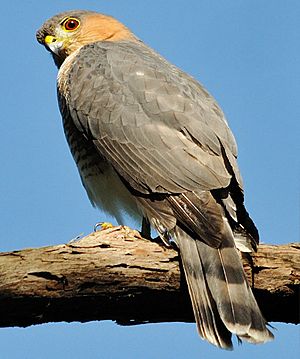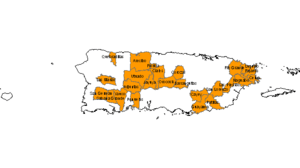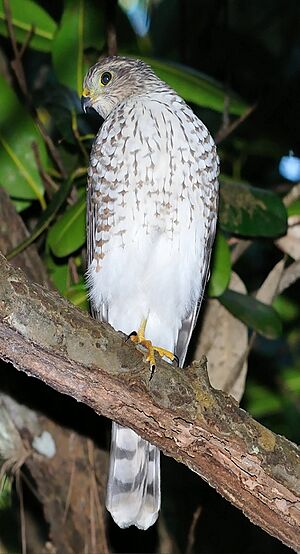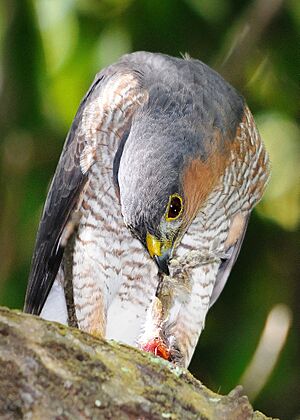Puerto Rican sharp-shinned hawk facts for kids
Quick facts for kids Puerto Rican sharp-shinned hawk |
|
|---|---|
 |
|
| Adult | |
| Conservation status | |
| Scientific classification |
|
| Kingdom: | Animalia |
| Phylum: | Chordata |
| Class: | Aves |
| Order: | Accipitriformes |
| Family: | Accipitridae |
| Genus: | Accipiter |
| Species: | |
| Subspecies: |
A. s. venator
|
| Trinomial name | |
| Accipiter striatus venator Wetmore (1914)
|
|
 |
|
| Approximate range in orange | |
The Puerto Rican sharp-shinned hawk is a special bird of prey found only in Puerto Rico. Its scientific name is Accipiter striatus venator. In Spanish, people call it falcón de sierra or gavilán pecho rufo. This hawk is a type of sharp-shinned hawk from North America, but it's a unique subspecies that lives only on the island.
This hawk was first discovered in 1912. Because its numbers are dropping quickly, it is now on the United States Fish and Wildlife Service list of endangered species. You might be able to spot it in the Toro Negro State Forest.
Contents
What Does It Look Like?
The Puerto Rican sharp-shinned hawk is a small forest hawk. It measures about 28–33 cm (11–13 in) long. Its back is a dark blue or slate gray color. Its chest has pretty reddish-orange stripes. Young hawks are brownish on their backs and have stripes underneath.
This hawk has wide wings and a long, square-shaped tail. These features help it turn and move very fast. This is important when it chases small birds through the forest canopy. Female hawks are much larger than males, sometimes almost 50% bigger. This difference in size helps them hunt different types of prey.
Behavior and Diet
The Puerto Rican sharp-shinned hawk mainly eats small birds. These can range from tanagers to tiny hummingbirds. Each hawk needs a hunting area of about 150 hectares (370 acres).
The female hawk lays two to three white eggs in March or April. She sits on the eggs to keep them warm while the male finds food for her. The eggs hatch in about 32 days. The young birds leave the nest about 30 days after they hatch.
The hawk's diet mostly includes small birds that weigh about 30 grams (1.1 ounces) or less. Because female hawks are bigger, they might also catch larger birds like some thrashers, which can weigh around 100 grams (3.5 ounces).
Where Do They Live?
These hawks live in only five separate mountain forest areas in Puerto Rico. These areas are subtropical wet forests. Since 1992, their population has dropped by 40%. In 1997, there were only about 150 of these birds left.
Many things have caused their numbers to go down. People building roads, power lines, and communication towers have cut down their forest homes. Big storms like hurricanes also hurt their population. Sometimes, young birds in the nest get sick from botfly or warble fly larvae. Other birds, like the pearly-eyed thrasher (Margarops fuscatus), sometimes eat their eggs or young.
After Hurricane Maria hit Puerto Rico, the Peregrine Fund found only 19 sharp-shinned hawks on the island. They have started a crisis fund campaign to help save this special bird.
Nesting and Reproduction
Puerto Rican sharp-shinned hawks choose places to build nests in both tree plantations and natural forests. They look for spots with lots of trees and mountains. They like areas where the tree branches are close together and the plants are thick.
They build their nests on horizontal branches, usually close to the tree trunk or in a fork of branches. They start building their nests in January. Both the male and female hawks work on the nest about a month before eggs are laid.
Eggs are usually laid in March and April. Sometimes, if the first set of eggs is lost, they might lay a second set between May and July. The eggs hatch after about one month. The young hawks stay in the nest until they can fly short distances. Then they will rest in trees about 10 to 15 meters (32 to 48 ft) from the nest. More than half of the young birds that don't survive are affected by warble fly larvae.
Courtship and Foraging
When the hawks first arrive at their nesting sites, they spend time on courtship displays. These are special flights and movements to attract a mate. Both male and female hawks do these displays, usually from sunrise until mid-morning.
In February, the female hawk stops looking for food and stays near the nest. Only the female sits on the eggs to incubate them. The male hawk's job is to bring all the food to the female during this time.





